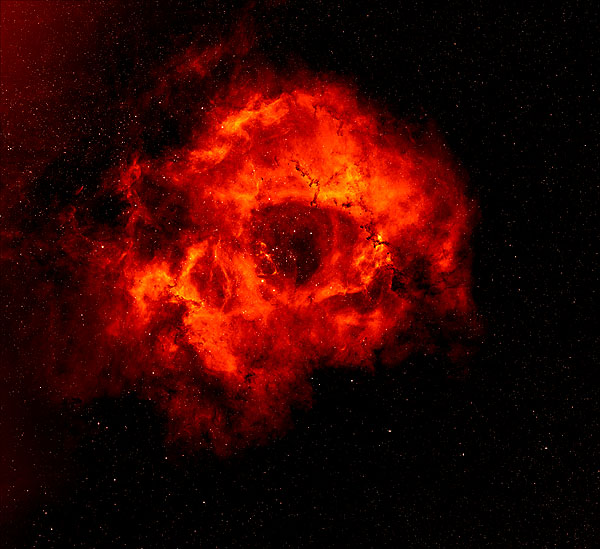 | |||
|
| Home > Public Information > Scientific Highlights > 2007 > The Most Detailed Image Ever Produced of the Rosette Nebula |
The Most Detailed Image Ever Produced of the Rosette Nebula | ||
|
INT+WFC
This new image of the Rosette Nebula (NGC 2237) is thought to be the most-detailed ever produced. Compiled from data taken from IPHAS, the Isaac Newton Telescope Photometric H-Alpha Survey of the Northern Galactic Plane, the image spans four square degrees,
about twenty times the size of the full moon.
The Rosette Nebula is a vast cloud of dust and gas spanning 100 light years and lying about 4500 light-years away. Inside the nebula lies a cluster of bright massive stars (NGC 2244), whose strong stellar winds and radiation have cleared a hole in the nebula's center. Ultraviolet light from these hot stars excites the surrounding nebula, causing it to glow. Star formation is still active around the nebula, as proven by the presence of a very young infrared star (AFGL 961) still in its final stages of formation. It is thought that the young massive stars in the nebula will one day blow all the gas and dust away. The centre of the Rosette Nebula is about 1.8 degrees below the Galactic Plane, the glow from which can be seen at the top left (northeastern) corner of this image. Due to its large angular size, most large telescopes are unable to capture the entire nebula in one exposure and therefore the highest resolution images have been limited to small areas of the nebula. IPHAS is in the process of imaging the entire Galactic Plane and members of the survey team were able to combine almost 200 individual CCD images to make this large and detailed H-alpha image. Even more detailed images of the central parts of the Rosette Nebula have also been prepared by the IPHAS team, including an image of dense dust lanes in the nebula where star formation may still be ongoing. IPHAS is a photometric imaging survey of the entire Northern Galactic Plane at three different wavelengths, using the Wide Field Camera on the 2.5m Isaac Newton Telescope to cover an area of 1800 square degrees. It is now close to completion and the first data release of the photometric point source catalogue is expected by June 2007. The survey will soon be followed by VPHAS+, a complementary Southern Galactic Plane survey using the ESO 2.5m VLT Survey Telescope (VST).
|
| Top | Back |
|


